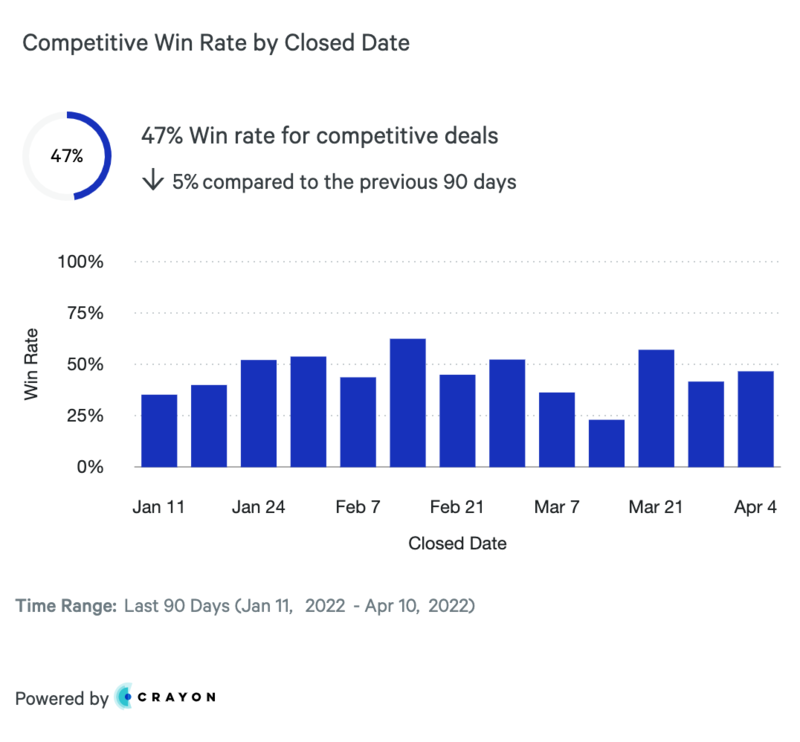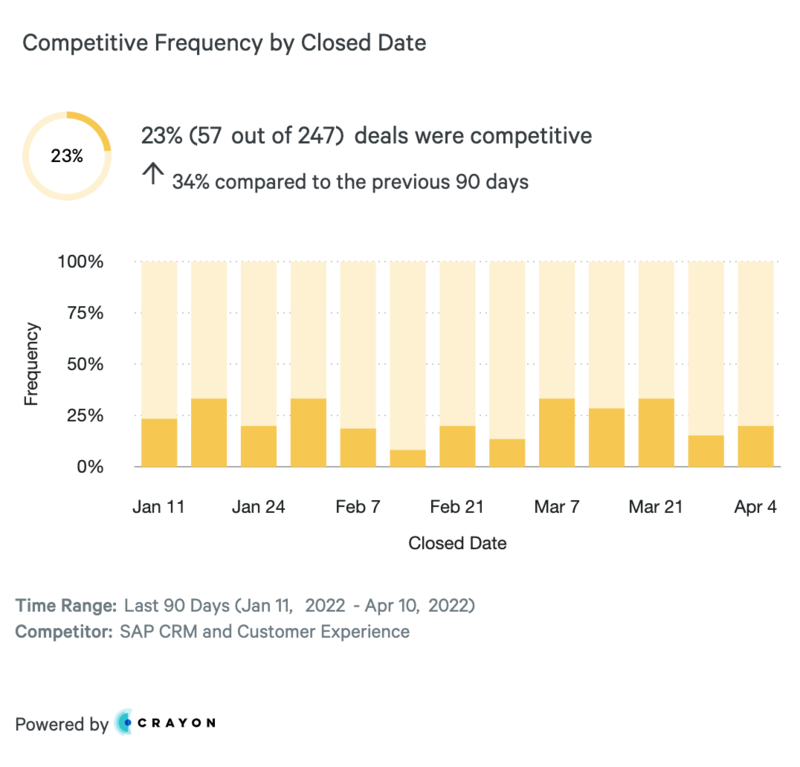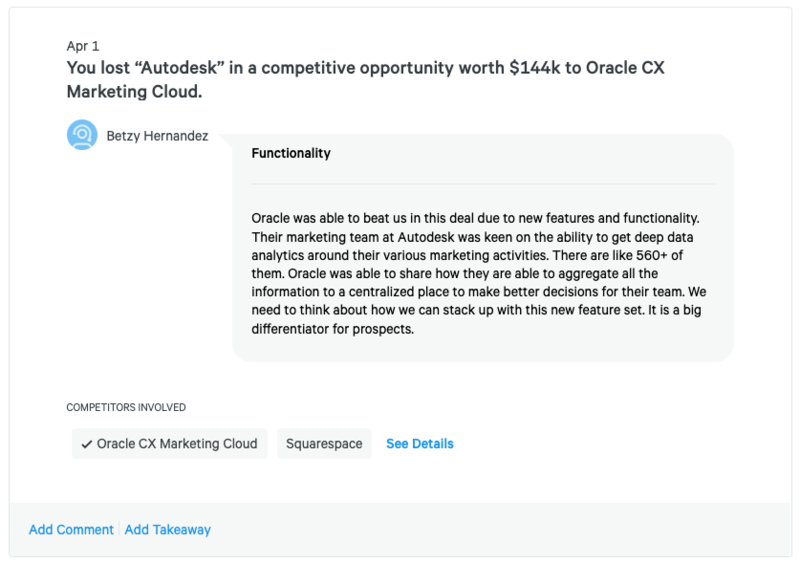It's Monday morning. You haven’t even taken the first sip of your coffee. You touch your right index finger to the magical biometric scanner thing on your MacBook. Your company-approved desktop wallpaper comes alive with apps.
And your heart sinks.
Your VP of Sales sent you a harrowing DM at 5:47am: "How are we performing against our competitors this quarter? How does that compare to our performance last quarter?"
Where do you begin?
These invaluable data aren’t derived through tasseography or the casting of bones, nor are they figments of your rich and limitless imagination.
No—a slog is afoot: You’ll need to log into Salesforce, pull a list of all the recently closed opportunities that involved at least one competitor, import that list into a Google Sheet, divide the number of opportunities won by the total number of opportunities, repeat this process for the previous quarter, and then create a chart that illustrates performance over time.
And then get back to your regularly scheduled programming (and stone-cold cup ‘o joe)—that is, until you’re asked for reports on three more competitors.
Have you provided value? Totally. But at what cost?
Allow us to suggest a different approach: Log into Crayon. Head to the Impact module. Blow the mind of the aforementioned sales leader. Profit.
In this post, we’ll show you how Crayon’s Impact module enables you to:
- Quantify the impact of your work
- Maximize the impact of your work
- Put time back in your day
Let's get into it.
Check out our webinar with Alex McDonnell, Head of M&CI at Airtable: How to Make Your Win Loss Project a Smashing Success (Before You Do a Single Interview).
Quantifying your impact
We are in the age of data-driven marketing.
Virtually every member of your marketing team owns a number. It’s their north star, serving as a measuring stick for performance. Site visitors, open rates, opportunities, qualified leads. It’s what’s helped shift the perception of marketing from cost center to profit center.
Unfortunately, product marketing is the only discipline that remains pretty much … numberless. It’s still perceived as “fluffy.”
But here’s the good news: As long as competitive intelligence sits firmly on your plate, the value that you deliver to your company is, in fact, measurable:

Ran a series of sales training sessions at the beginning of March? Well, based on the uptick in competitive win rate—automatically captured by Crayon in real time—I’d say it was a smashing success! And when you show this chart—downloadable as a PNG with the click of a button—at your next marketing team metrics meeting, your CMO will say the same thing.
Maximizing your impact
Competitive win loss reporting isn't just a reflection of past performance; it can also be directionally helpful—enabling you, the time-crunched PMM, to figure out where your effort is likely to yield the greatest ROI.
If you’ve got two competitors (against whom your sellers have roughly equal success) and only have enough time to optimize one battlecard before the end of the quarter, how do you decide where to focus your efforts?
Two words: Competitive frequency.

Competitive frequency skyrocketing with one competitor and plateauing with the other? Well, now you know which battlecard you need to focus on.
This is a prime example of quantitative win loss data helping you figure out who you need to focus on. But when endeavoring to enable sellers to win more competitive deals, you need to know not only who to focus on, but also what to focus on.
Enter qualitative win loss data.

That’s right: Crayon automatically pulls in the notes associated with your closed opportunities, providing yet another layer of insight for you to take into consideration as you’re figuring out where to invest your time and energy.
Go deeper with advanced filtering
Segmenting your win loss data by competitor and date range is an awesome start.
But which competitors tend to stick around until the final moments of the buying cycle, as opposed to bouncing at the discovery stage? How do your sellers perform when they’re competing for the business of enterprise prospects? Or how about when they’re competing for the business of prospects acquired through paid campaigns?
With Crayon, questions like these are easy to answer, as you can filter your data using customizable parameters—drawn directly from the fields in your Salesforce opportunity records.
Putting time back in your day
Quantifying and maximizing your impact sounds nice and all, but who’s got the time? The sad truth is that, for many PMMs inundated with more to do than time allows, exporting data from Salesforce, throwing it into a spreadsheet, and sinking days (if not weeks) into slicing and dicing it simply isn’t in the cards.
So why not automate it?
That’s right: Crayon’s Impact module isn’t simply a functionless facsimile of the same reports you’ve already got (and, let’s be honest, probably don’t look at) in Salesforce. This is a bonafide, bidirectional integration. It can be manipulated in Crayon; once you’ve connected the two platforms, you don’t need to go back to SFDC for any of your CI needs.
No data manipulation. No iFrames. And better still, everything can be downloaded as a PNG, complete with context (who, what, when).
More W’s and fewer L’s with Crayon’s Impact module
Our Impact module makes competitive win loss reporting better, easier, and faster.
Trying to manually replicate this integration is not only tremendously time-consuming—it's also risky, as there's ample opportunity for human error to rear its ugly head.
Can you do competitive win loss analysis using some frankensteined amalgam of Salesforce and Excel? Yeah, sure. This makes sense when your reps are losing deals because prospects won’t pick up the phone. But when they’re investing time and energy into a deal only to get it’s-not-you-it’s-me’d, Salesforce alone isn’t going to cut it.
When you’re losing deals to named competitors, you need to start conducting your competitive win loss analysis in the same place where you capture and analyze competitive intelligence in general. Doing so makes it easier to connect the dots, formulate counterpunches, and come out on top. What are you waiting for?

Seeing is believing! Check out Crayon for yourself.
Take a Product TourRelated Blog Posts
Popular Posts
-
 The 8 Free Market Research Tools and Resources You Need to Know
The 8 Free Market Research Tools and Resources You Need to Know
-
 6 Competitive Advantage Examples From the Real World
6 Competitive Advantage Examples From the Real World
-
 How to Create a Competitive Matrix (Step-by-Step Guide With Examples + Free Templates)
How to Create a Competitive Matrix (Step-by-Step Guide With Examples + Free Templates)
-
 24 Questions to Consider for Your Next SWOT Analysis
24 Questions to Consider for Your Next SWOT Analysis
-
 How to Measure Product Launch Success: 12 KPIs You Should Be Tracking
How to Measure Product Launch Success: 12 KPIs You Should Be Tracking



